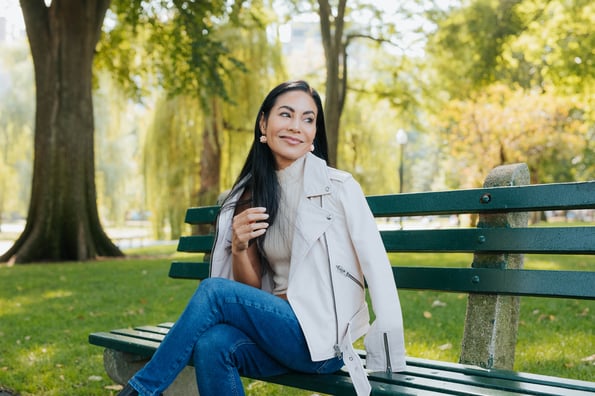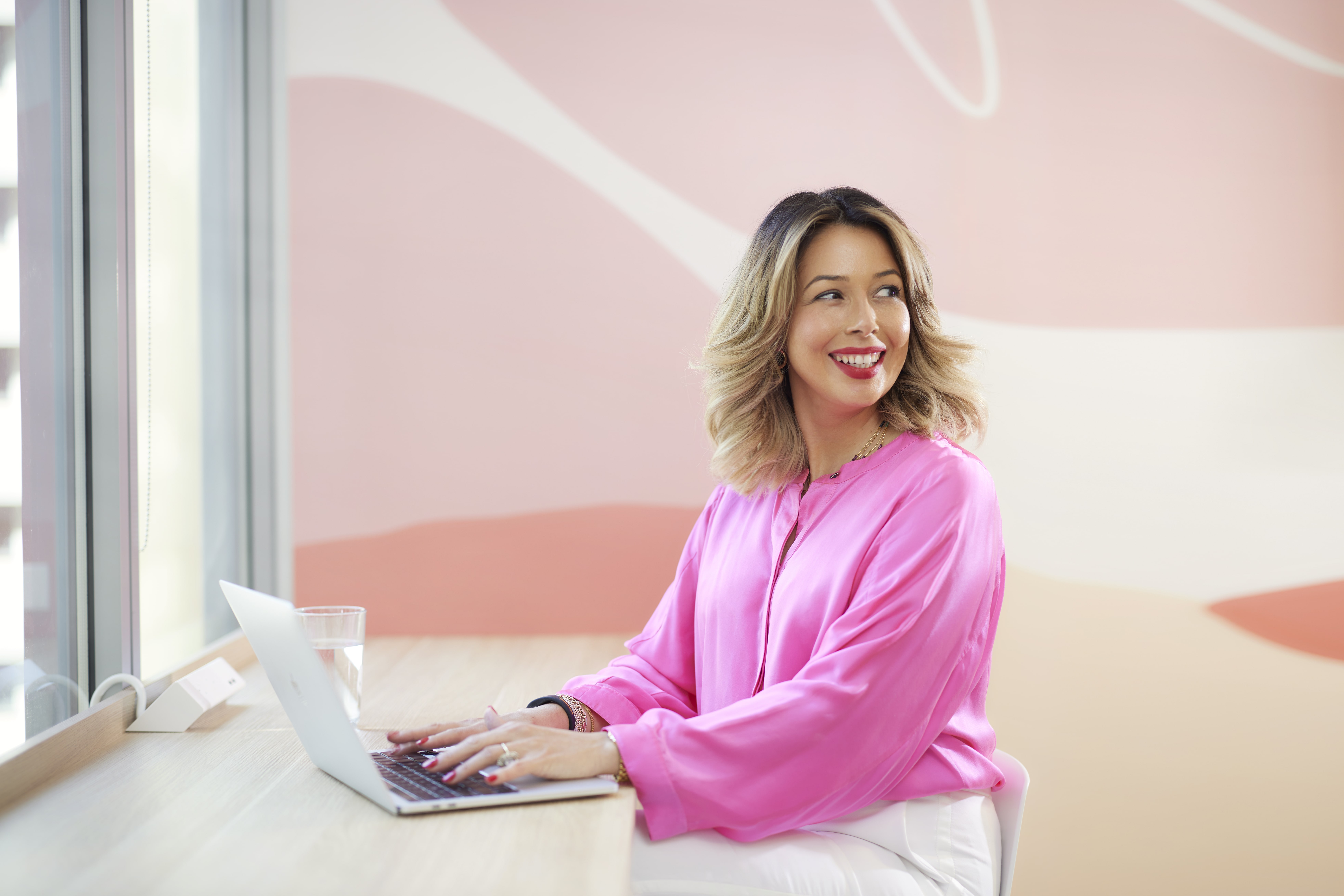The 2022 Stitch Fix Style Forecast shows a prolonged move toward comfortable attire: 50% of surveyed people said the workplace has become more casual post-covid, with 45% saying they prefer sweatpants over suits.

Briefcases, brogues, and starched shirts have been replaced by more relaxed clothing choices — practical backpacks, cotton polos, and loafers — even in more formal industries.
In 2023, 76% of people are reportedly opting for clothing that can be worn for work and the weekend — hence, the rise of business casual attire.
What Is Business Casual?
Business casual is a dress code that balances professional attire and casual clothing, commonly adopted in workplaces that value a relaxed yet polished appearance.
It typically includes items like slacks, blouses or collared shirts, skirts or dresses, and closed-toe shoes, allowing individuals to express their personal style while maintaining a level of professionalism.
The Rise of Business Casual Wear
Since the start of the pandemic, workwear has shifted toward more casual business attire.
Stitch Fix’s report found that 47% of people wear the same thing for work as they do outside of work or on the weekend. That's because the business casual dress code creates room for self-expression through workwear, with a level of comfort and style.
However, the definition of business casual varies from company to company. Blazers might be more common at an advertising agency, while jeans might be more appropriate in a laid-back startup workspace.
Ultimately, your workplace, company culture, industry, and seasonal variations will help you understand how to align your casual outfits and feel confident.
While some companies allow — and even encourage — workers to dress casually for comfort, it’s easy to forget the importance of proper office attire.
Importance of Maintaining a Professional Image
Turns out, the “dress for success” motto has huge implications — even amid today’s casual office dress code.
Besides boosting self-confidence, maintaining a professional image in the workplace helps you:
- Make a good first impression: People make initial judgments and long-term opinions about your character, competence, credibility, and commitment based on your appearance and how you dress.
- Communicate that you’re serious about your job: Maintaining a professional image through your workwear sends the message that you value your work and how you represent yourself.
- Represent your organization: You’re a representative of your company in business dealings with the public. Maintaining professionalism, even in business casual workwear, could indirectly mean the difference between closing deals and losing the opportunity. It communicates that you consider yourself a company ambassador and improves the reception you receive.
Business Casual Examples
Recruiters or hiring managers often share dress code specifications and guidelines employees should know before their first day of work during job interviews or when onboarding.
If your workplace has a vague business casual dress code, below are examples to set you in the right direction.
Business Casual Work Outfits for Men
Shirts
Replace the typical dress shirt with a more casual, button-down collar style that’s still professional and suited to the office environment. You won’t be wearing a tie, so go for a slim or classic-fit shirt with a nicely fitted collar.
The business casual style gives you some leeway regarding what you can wear, but your company culture will still influence your choices.
For example, a button-down collar shirt will work if you’re in a client-facing role like sales, while a trim-fit polo shirt will usually fly in creative roles or tech startups.
Pants
Go for khaki pants or elevated chinos — a popular business casual go-to — provided they fit well and are within your budget. If your workplace is more casual, get classic cotton pants with a tapered fit; they’re an accessible and comfortable choice over traditional dress pants.
Again, depending on your role and company culture, choose colors wisely. For example, if you’re in sales, you can be bolder in your pant color choices. If you’re in a creative role, dark denim is fine, or more obscure chino colors, like olive, that match the rest of your outfit.
Then, get a few pairs of dark socks to go with your business casual attire.
Shoes
Dress shoes can upgrade almost any outfit, but with the business casual dress code, you can be more creative — if your office culture allows it.
Besides the classic Oxford and derby dress shoes, penny loafers, brogues, Chelsea boots, and monk straps can elevate your look. Make sure your belt and watch match the color of your shoes.
Brown is a good color choice for more official, client-facing roles. Creative roles and tech startups can get away with sneakers, dress shoes, suede shoes, and more colorful boots.
Jackets and blazers
Add a single-breasted blazer or jacket to your standard business casual outfit for a touch of class or formality — especially if you’re in a more traditional white-collar environment like finance or law. A tweed sport coat or corduroy jacket also works, but stick to subtle patterns and dark colors.
In colder climates, stick to slim-fit cardigans or sweaters with neutral colors like brown, navy, beige, or black, and subtle patterns that tone well with your pants.
Accessories
You’re still in a work environment, so pair your outfit with natural and elegant accessories, like a casual watch or dress watch. Add unique, simple metal cuffs to complete the look.
Business Casual Work Outfits for Women
Here’s an overview of business casual wear for women:
Blouses
Work-appropriate blouses have sleeves and are not sheer. Get a collared or noncollared blouse with tasteful patterns or solid colors to achieve a business casual workwear look. Some examples include the cowl neck, bow tie, and silk or rayon blouses.
Dresses and skirts
A dress at or below the knee is ideal for business casual attire. Pair it with a cardigan or blazer for a polished look or to keep warm in colder months. Wear a dress with sleeves in warmer months to avoid looking too casual.
Printed or colored A-line skirts and pencil skirts with a cotton or wool blend are appropriate business casual outfits. Avoid denim skirts, which are more suitable for outside-of-work and weekend wear.
Pants
If you buy trousers separately from a suit, wear slim-fit tapered khakis or bootcut trousers.
Colored and patterned pants might not be appropriate workwear, depending on your office culture. For instance, a solid, neutral-colored pair are better suited for more conservative settings, where pants with subtle patterns and jeweled tones are allowed.
If your workplace allows jeans, stick to a darker tint free of tears and rips. Avoid oversized denim and skintight jeans.
Accessories
Pair your business casual apparel with a relaxed organizer purse or classic handbag suited for the workplace or business settings.
To add some zest to your outfit, wear modest, understated jewelry, such as a simple necklace and stud earrings that don’t make sounds as you move and aren’t overly distracting. Add a simple watch to complete your look.
The key is to create a comfortable, polished, and professional appearance that’s not too stuffy or formal.
Business Casual Tips
When picking out your business casual outfit, there are some standard guidelines on what you should and shouldn’t do.
Here are some tips to keep in mind:
- Pay attention to the fit and avoid anything too short, tight-fitting, overly revealing, sloppy, or unkempt that isn’t tailored to your body.
- Avoid crop tops, blouses with plunging necklines, and bare shoulders.
- Stick to classic styles and clean lines.
- Keep clothing colors conservative with neutral colors like gray, navy, and black, and small patterns or subtle prints.
- Pick quality fabrics like silk, cotton, wool, twill, linen, and corduroy.
- Make sure your business clothing is comfortable and makes you feel confident.
- Avoid athletic sneakers, casual sandals, steel-toed work boots, and flip-flops. Instead, get dress sneakers.
- Keep accessories and jewelry simple and understated — not loud or flashy.
- Opt for upgraded jeans or dark-wash denim with a slim silhouette.
Nailing the business casual look can be tough. The best approach is to lean toward a corporate dress code; then, as you learn the business etiquette in your office, you can find what works for you.




 (1).png)

